2013.5 Peugeot 308 CC roof
[x] Cancel search: roofPage 6 of 268
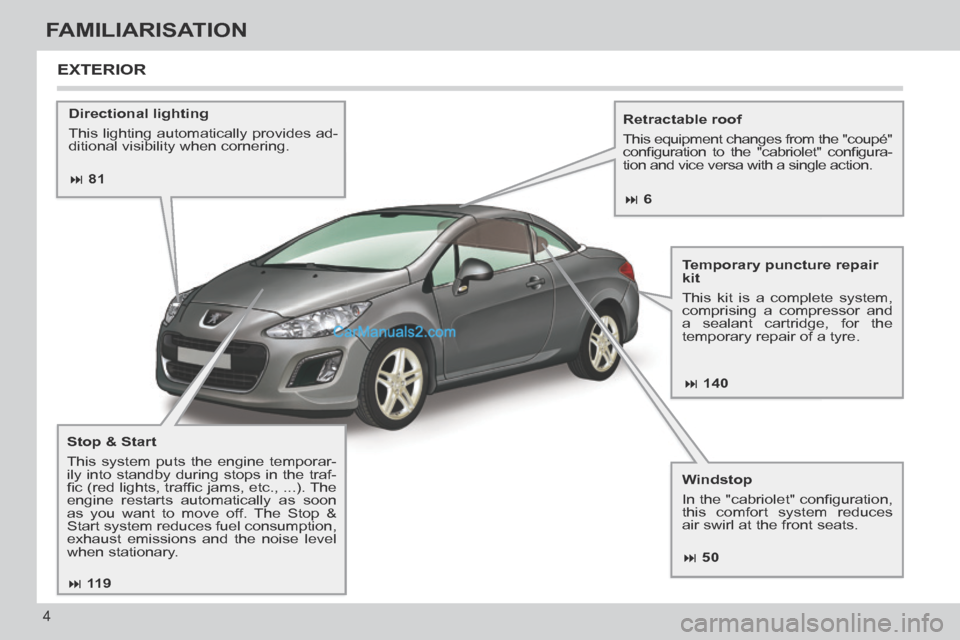
81 140
50
11 9
6
4
FAMILIARISATION
Directional lighting
This lighting automatically provides ad-
ditional visibility when cornering. Retractable roof
This equipment changes from the "coupé"
confi guration to the "cabriolet" confi gura-
tion and vice versa with a single action.
Windstop
In the "cabriolet" confi guration,
this comfort system reduces
air swirl at the front seats.
EXTERIOR
Temporary puncture repair
kit
This kit is a complete system,
comprising a compressor and
a sealant cartridge, for the
temporary repair of a tyre.
Stop & Start
This system puts the engine temporar-
ily into standby during stops in the traf-
fi c (red lights, traffi c jams, etc., ...). The
engine restarts automatically as soon
as you want to move off. The Stop &
Start system reduces fuel consumption,
exhaust emissions and the noise level
when stationary.
Page 8 of 268
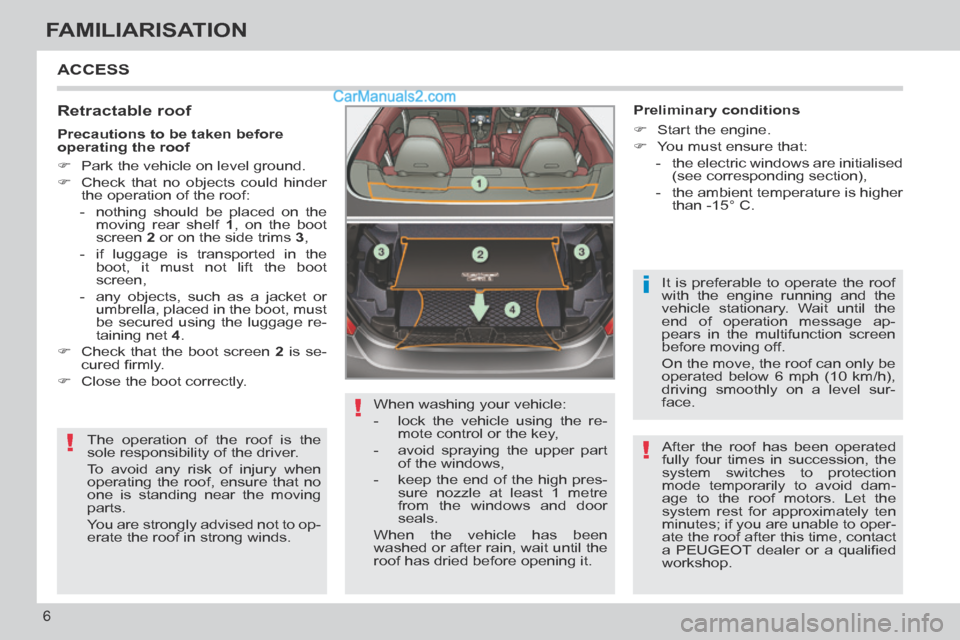
!
!
i
!
6
FAMILIARISATION
ACCESS
Retractable roof
The operation of the roof is the
sole responsibility of the driver.
To avoid any risk of injury when
operating the roof, ensure that no
one is standing near the moving
parts.
You are strongly advised not to op-
erate the roof in strong winds. When washing your vehicle:
- lock the vehicle using the re-
mote control or the key,
- avoid spraying the upper part of the windows,
- keep the end of the high pres- sure nozzle at least 1 metre
from the windows and door
seals.
When the vehicle has been
washed or after rain, wait until the
roof has dried before opening it. It is preferable to operate the roof
with the engine running and the
vehicle stationary. Wait until the
end of operation message ap-
pears in the multifunction screen
before moving off.
On the move, the roof can only be
operated below 6 mph (10 km/h),
driving smoothly on a level sur-
face.
Preliminary conditions
Start the engine.
You must ensure that:
- the electric windows are initialised (see corresponding section),
- the ambient temperature is higher than -15° C.
Precautions to be taken before
operating the roof
Park the vehicle on level ground.
Check that no objects could hinder
the operation of the roof:
- nothing should be placed on the moving rear shelf 1 , on the boot
screen 2 or on the side trims 3 ,
- if luggage is transported in the boot, it must not lift the boot
screen,
- any objects, such as a jacket or umbrella, placed in the boot, must
be secured using the luggage re-
taining net 4 .
Check that the boot screen 2 is se-
cured fi rmly.
Close the boot correctly.
After the roof has been operated
fully four times in succession, the
system switches to protection
mode temporarily to avoid dam-
age to the roof motors. Let the
system rest for approximately ten
minutes; if you are unable to oper-
ate the roof after this time, contact
a PEUGEOT dealer or a qualifi ed
workshop.
Page 9 of 268
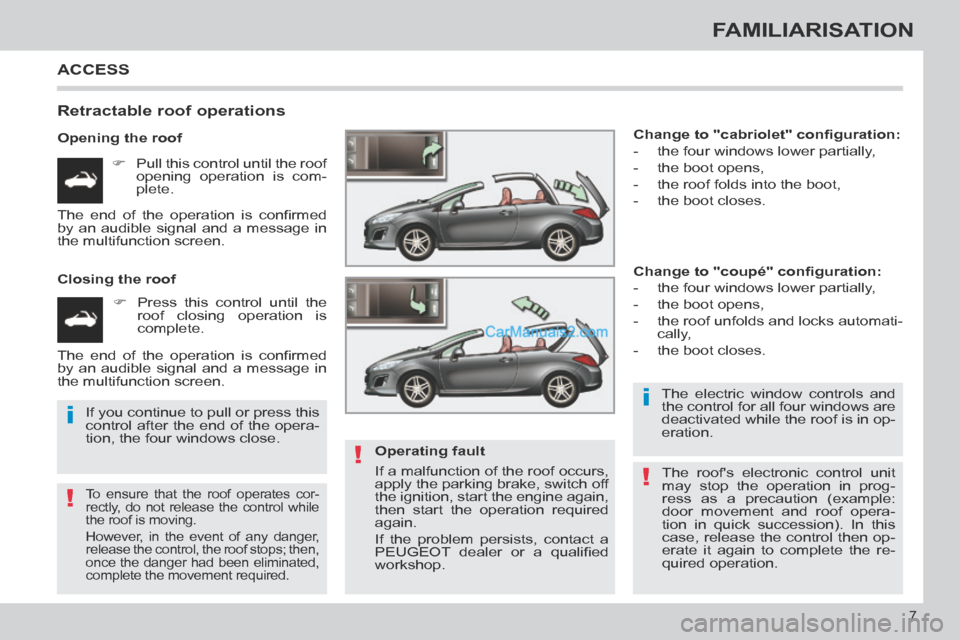
!
i
!
i
!
7
FAMILIARISATION
ACCESS
Retractable roof operations
Opening the roof Pull this control until the roof opening operation is com-
plete.
Closing the roof Press this control until the roof closing operation is
complete. Change to "cabriolet" confi guration:
- the four windows lower partially,
- the boot opens,
- the roof folds into the boot,
- the boot closes.
Change to "coupé" confi guration:
- the four windows lower partially,
- the boot opens,
- the roof unfolds and locks automati-
cally,
- the boot closes.
To ensure that the roof operates cor-
rectly, do not release the control while
the roof is moving.
However, in the event of any danger,
release the control, the roof stops; then,
once the danger had been eliminated,
complete the movement required.
Operating fault
If a malfunction of the roof occurs,
apply the parking brake, switch off
the ignition, start the engine again,
then start the operation required
again.
If the problem persists, contact a
PEUGEOT dealer or a qualifi ed
workshop. The electric window controls and
the control for all four windows are
deactivated while the roof is in op-
eration.
The end of the operation is confi rmed
by an audible signal and a message in
the multifunction screen.
The end of the operation is confi rmed
by an audible signal and a message in
the multifunction screen.
If you continue to pull or press this
control after the end of the opera-
tion, the four windows close.
The roof's electronic control unit
may stop the operation in prog-
ress as a precaution (example:
door movement and roof opera-
tion in quick succession). In this
case, release the control then op-
erate it again to complete the re-
quired operation.
Page 12 of 268

10
FAMILIARISATION
INSTRUMENTS AND CONTROLS
1. Steering wheel adjustment control.
2. Cruise control / speed limiter switches.
3. Lighting and direction indicator control stalk.
4. Central adjustable air vents.
5. Multifunction screen.
6. Sunshine sensor.
7. Passenger's front airbag.
8. Glove box / Audio/video sockets / Fusebox.
9. Bonnet release.
10. Retractable roof control.
Control for all four windows.
11 . Storage compartment.
12. "AIRWAVE" system controls.
13. Front armrest.
14. Front ashtray.
15. Heating / air conditioning controls.
16. Audio and telematics system.
17. Emergency call button.
Alarm button.
Central locking button.
Hazard warning lamps button.
Dynamic stability control (DSC/ASR systems) button.
Parking sensors button.
PEUGEOT services button.
Page 21 of 268

19
ECO-DRIVING
Eco-driving is a range of everyday practices that allow the motorist to \
optimise their fuel consumption and CO2 emissions.
Optimise the use of your gearbox
With a manual gearbox, move off gently and change up
without waiting. During acceleration change up early.
With an automatic or electronic gearbox, give preference to
automatic mode and avoid pressing the accelerator pedal
heavily or suddenly.
The gear shift indicator invites you engage the most suitable
gear: as soon as the indication is displayed in the instru-
ment panel, follow it straight away.
For vehicles fi tted with an electronic or automatic gearbox,
this indicator appears only in manual mode.
Drive smoothly
Maintain a safe distance between vehicles, use engine
braking rather than the brake pedal, and press the accel-
erator progressively. These practices contribute towards a
reduction in fuel consumption and CO
2 emissions and also
helps reduce the background traffi c noise.
If your vehicle has cruise control, make use of the system at
speeds above 25 mph (40 km/h) when the traffi c is fl owing
well.
Control the use of your electrical equipment
Before moving off, if the passenger compartment is too
warm, ventilate it by opening the windows and air vents
b efore using the air conditioning.
Above 30 mph (50 km/h), close the windows and leave the
air vents open.
Remember to make use of equipment that can help keep the
temperature in the passenger compartment down (s unroof
and window blinds...).
Switch off the air conditioning, unless it has automatic regu-
lation, as soon as the desired temperature is attained.
Switch off the demisting and defrosting controls, if not
a utomatic.
Switch off the heated seat as soon as possible.
Switch off the headlamps and front foglamps when the level
of light does not require their use.
Avoid running the engine before moving off, particularly in
winter; your vehicle will warm up much faster while driving.
As a passenger, if you avoid connecting your multimedia
devices (fi lm, music, video game...), you will contribute
t owards limiting the consumption of electrical energy, and
so of fuel.
Disconnect your portable devices before leaving the vehicle.
Page 22 of 268
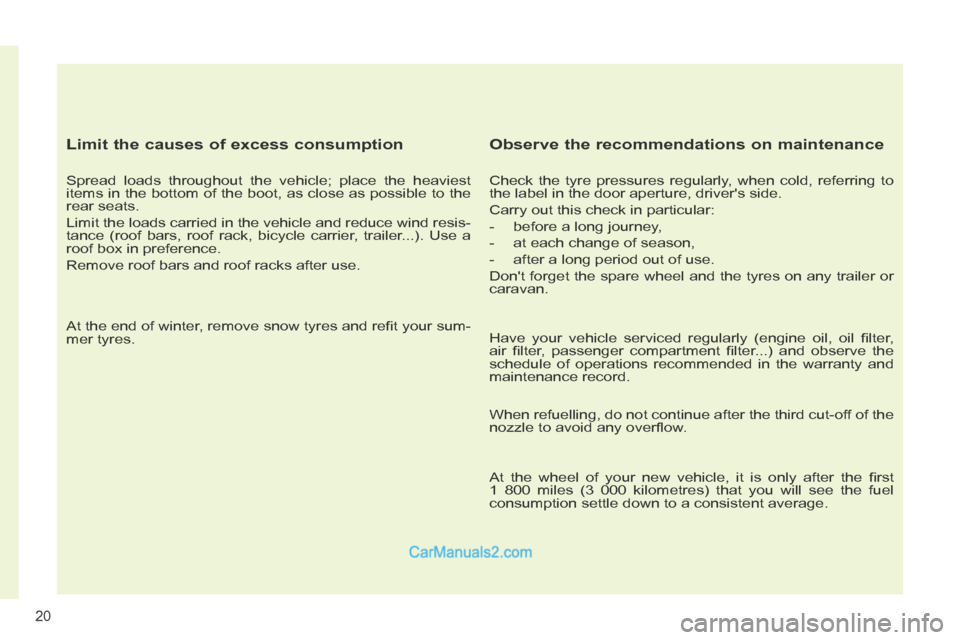
20
Limit the causes of excess consumption
Spread loads throughout the vehicle; place the heaviest
items in the bottom of the boot, as close as possible to the
rear seats.
Limit the loads carried in the vehicle and reduce wind resis-
tance (roof bars, roof rack, bicycle carrier, trailer...). Use a
roof box in preference.
Remove roof bars and roof racks after use.
At the end of winter, remove snow tyres and refi t your sum-
mer tyres.
Observe the recommendations on maintenance
Check the tyre pressures regularly, when cold, referring to
the label in the door aperture, driver's side.
Carry out this check in particular:
- before a long journey,
- at each change of season,
- after a long period out of use.
Don't forget the spare wheel and the tyres on any trailer or
caravan.
Have your vehicle serviced regularly (engine oil, oil fi lter,
air fi lter, passenger compartment fi lter...) and observe the
schedule of operations recommended in the warranty and
maintenance record.
When refuelling, do not continue after the third cut-off of the
nozzle to avoid any overfl ow.
At the wheel of your new vehicle, it is only after the fi rst
1 800 miles (3 000 kilometres) that you will see the fuel
c onsumption settle down to a consistent average.
Page 44 of 268

2
!
i
42
MULTIFUNCTION SCREENS
"SETUP" menu
Press the "SETUP" button to gain
access to the confi guration menu:
- "Display confi guration",
- "Voice synthesiser",
- "Choice of language",
- "Vehicle settings",
- "Alert log".
For safety reasons, confi guration
of the multifunction screen by the
driver must be done only when sta-
tionary.
Displays in the screen
Depending on the context, it displays:
- time,
- date,
- altitude,
- ambient temperature (the value dis- played fl ashes if there is a risk of
ice),
- the sequences of opening and clos- ing the roof,
- visual parking sensor information,
- audio functions,
- telephone information and direc- tories,
- satellite navigation system infor- mation,
- settings menus for the screen, navi- gation system and vehicle equip-
ment.
RETRACTABLE COLOUR SCREEN (WITH PEUGEOT CONNECT NAVIGATION (RT6)) Controls
From the navigation system control
panel, to select one of the applications:
press the dedicated "RADIO" ,
"MUSIC" , "NAV" , "TRAFFIC" ,
"PHONE" or "SETUP" button to
gain access to the corresponding
menu,
turn the knob A to select a function,
an item in a list,
press button B to confi rm the selec-
tion,
or
press the "Back" button to abandon
the current operation and return to
the previous display. For operation of the retractable
screen (opening, closing, adjust-
ment of the position, etc.), refer to
the section "Access to the retract-
able screen".
For more information on these applica-
tions, refer to the "PEUGEOT Connect
Navigation (RT6)" section.
Page 49 of 268
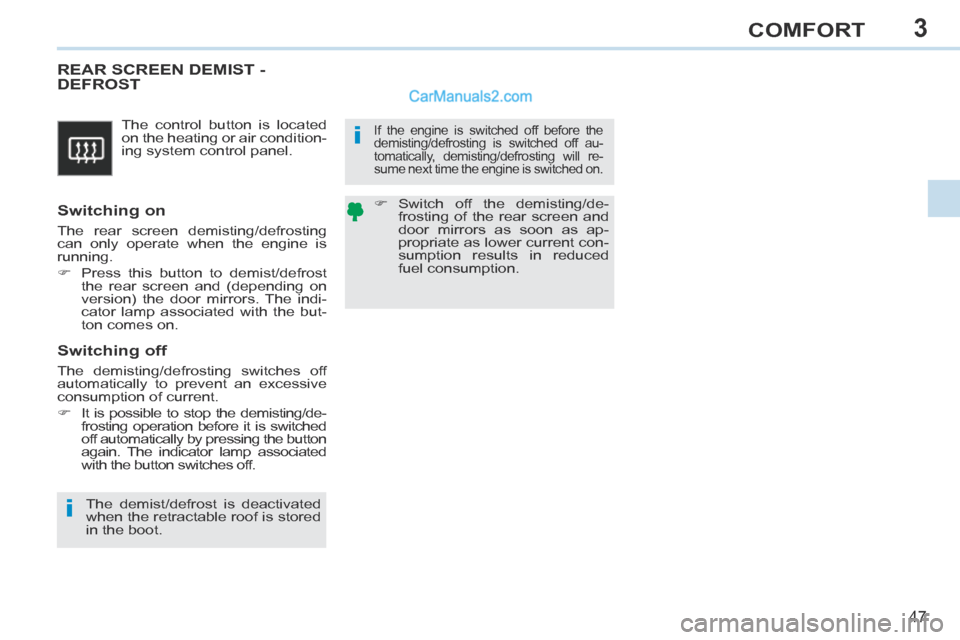
3
i
i
47
COMFORT
The control button is located
on the heating or air condition-
ing system control panel.
REAR SCREEN DEMIST - DEFROST
Switching on
The rear screen demisting/defrosting
can only operate when the engine is
running.
Press this button to demist/defrost the rear screen and (depending on
version) the door mirrors. The indi-
cator lamp associated with the but-
ton comes on.
Switching off
The demisting/defrosting switches off
automatically to prevent an excessive
consumption of current.
It is possible to stop the demisting/de-frosting operation before it is switched
off automatically by pressing the button
again. The indicator lamp associated
with the button switches off.
If the engine is switched off before the
demisting/defrosting is switched off au-
tomatically, demisting/defrosting will re-
sume next time the engine is switched on.
Switch off the demisting/de-frosting of the rear screen and
door mirrors as soon as ap-
propriate as lower current con-
sumption results in reduced
fuel consumption.
The demist/defrost is deactivated
when the retractable roof is stored
in the boot.